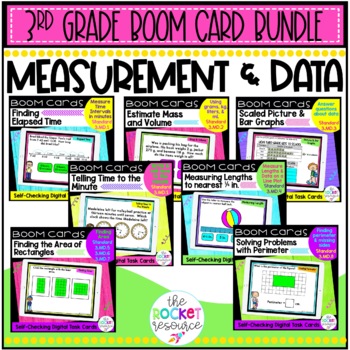Measurement and Data 3rd Grade BOOM Cards Bundle | time | graphs | measurement
- Zip
- Internet Activities
What educators are saying
Products in this Bundle (7)
showing 1-5 of 7 products
Bonus
Also included in
- Need an easy, no-prep way to practice third grade math standards? Get a BOOM deck to cover every third grade math standard with this comprehensive, money-saving bundle! This bundle includes 26 BOOM decks to cover every 3rd grade Common Core math standards. Decks contain between 25-40 cards and a vPrice $62.00Original Price $77.50Save $15.50
Description
Your students will love practicing measurement and data with these fun decks! This third grade measurement and data bundle covers telling time to the nearest minute, finding elapsed time, estimating mass and volume, using scaled picture graphs and bar graphs, measuring length to the nearest half and fourth inch, finding the area of rectangles, and finding perimeter. Decks cover each of the 3rd grade measurement and data standards 3.MD.1, 3.MD.2, 3.MD.3, 3.MD.4, 3.MD.5, 3.MD.6, 3.MD.7, 3.MD.8. Each deck contains 30+ cards and a variety of card types. Purchase the bundle to save 20%!
BUNDLE INCLUDES THE FOLLOWING BOOM DECKS:
- Time to the Nearest Minute (3.MD.1)
- Elapsed Time (3.MD.1)
- Estimating Mass and Volume (3.MD.2)
- Picture Graphs and Bar Graphs (3.MD.3)
- Measuring to the Nearest half and fourth inch (3.MD.4)
- Finding area of rectangles (3.MD.5, 3.MD.6, 3.MD.7)
- Finding perimeter of polygons (3.MD.8)
WHAT YOU NEED:
Boom cards must be used with the Internet. They can be played on recent browsers (Chrome, Safari, Firefox, etc.) or with the app (available for iPad, Android, iPhone, Kindle Fire). You can assign Boom cards for free using the "Fast Pins" option. For more options, you can sign up for a premium Boom Learning account.
✸✸✸Once purchased, GET YOUR ONE-CLICK BUNDLE LINK IN THE INCLUDED BONUS FILE.✸✸✸
Don't forget that leaving feedback earns you points towards FREE TPT purchases. I love feedback.
Click here to follow me and be notified when new products are uploaded. ★Products are 50% off during the first 48 hours!!★
OTHER PRODUCTS YOU MAY BE INTERESTED IN:
Find me online at The Rocket Resource for questions, tips, and more!






